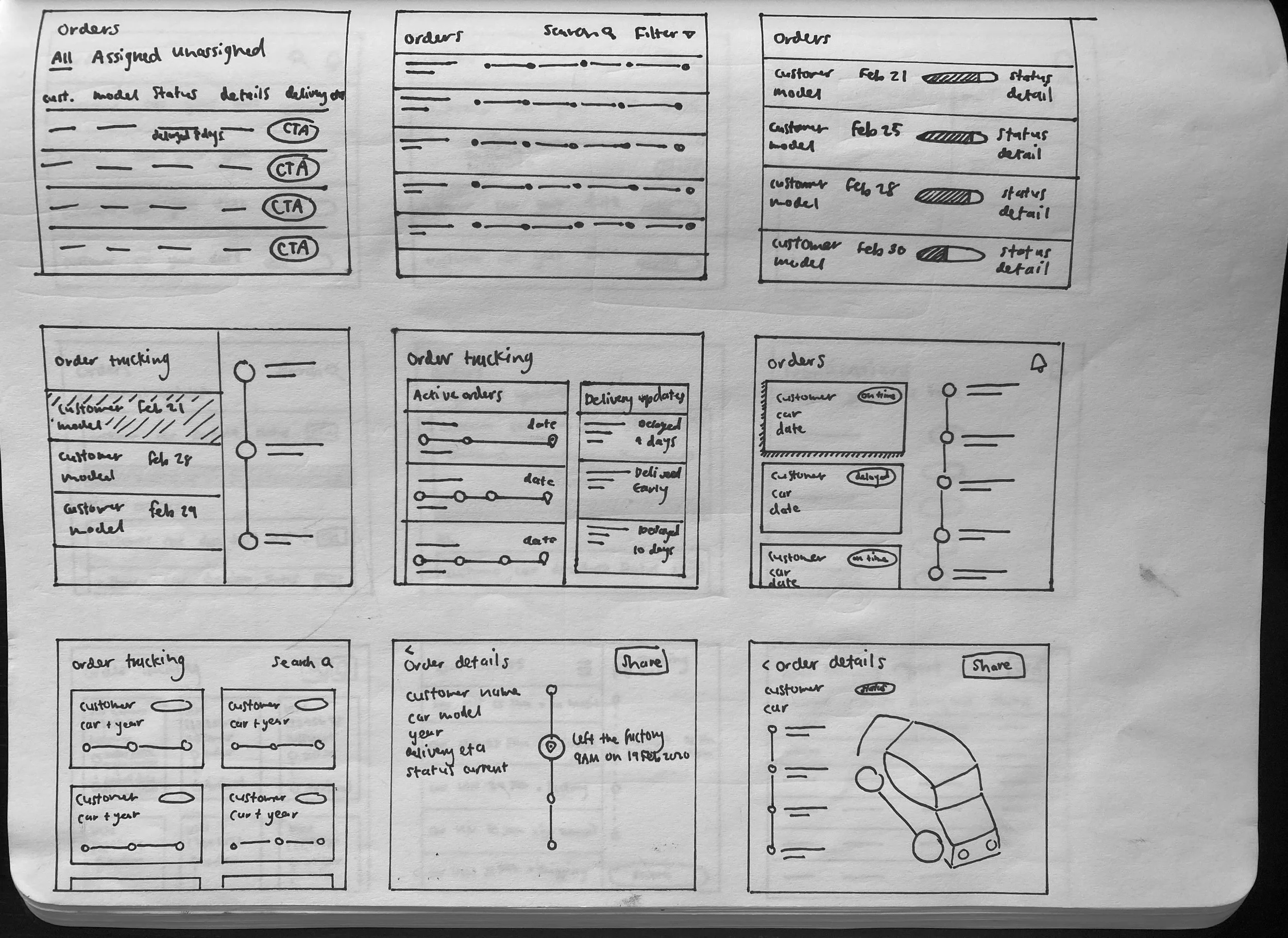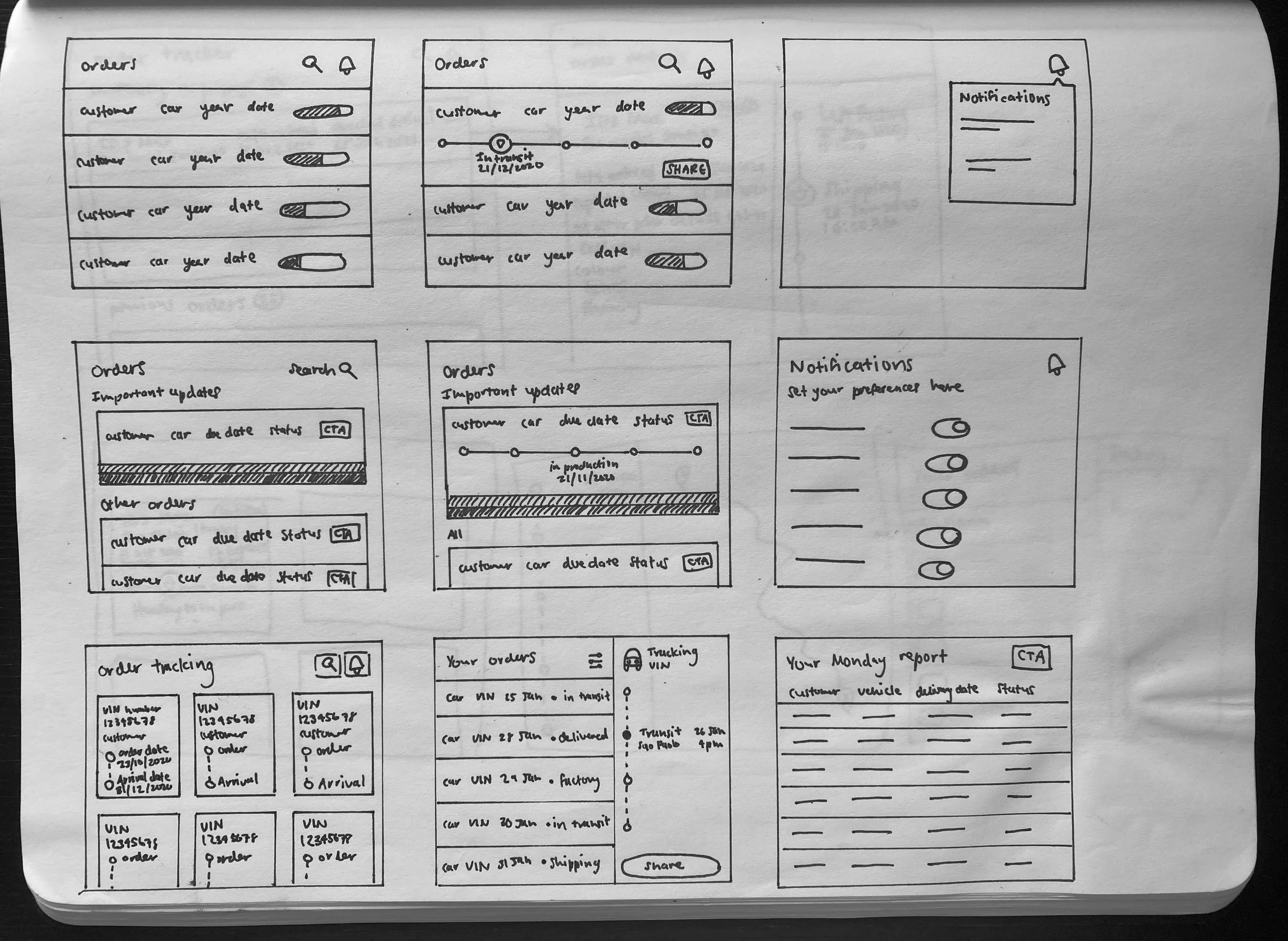Vehicle Order Tracker
UX Research • Workshop Facilitation • Product Design
-
Overview
Vehicle order tracking application for Volkswagen Group dealerships.
-
Client
Volkswagen Passenger Vehicles
-
Role
Senior Product Designer
-
Timeline
12 Month Project
-
Methods
+ Stakeholder and user interviews + Affinity map + User journey map + Competitive benchmarking + Best practice research + Ideation workshop + Wireframe sketches + User interface design + Usability test
The challenge.
Dealerships, globally, lacked a single system to track car orders once they had been placed at the factory. They had multiple, outdated systems to work with and no single point of reference to track all orders. This had a direct, negative impact on the customer experience as they were not actively informed on the status of their order and the date of arrival, meanwhile they would have to wait an average of three months for their car to arrive.
The process.
We kicked-off the process by conducting stakeholder interviews to gain more context from the business’ perspective. As the problem was originally identified by the business, we wanted to unpack it further with them, before conducting our own research on whether the problem was real and worth solving for our users.
Next, we created a user research plan and facilitated user interviews with salespeople in different dealerships across Europe. With an overarching research question that we wanted to answer in mind:
“Will a car status tracker help empower the salesperson to assist customers with their orders and keep them informed and excited throughout the process?”
Our research objectives were:
Learn how dealers currently track their car build status.
Understand dealer’s top problems, needs and opportunities with customers between when the car is ordered up until delivery.
What information and services are offered to customers once they’ve ordered a car and before it is delivered.
What information does the dealer actually care to see and be informed about.
What Salespeople said
“It’s a long logistic road until it gets to the customer, with a lot of black holes.”
— Salesperson from Sweden
“Sometimes when I have a lot of work, I forget about one car. Then I see, oh gosh, it's been in the showroom for one week already and I could have given it to the customer.”
— Salesperson from Poland
“My main focus needs to be selling. I shouldn’t have to be fixing problems that aren’t my problems.”
— Salesperson from Portugal
“If we can track the car every day, that would be a huge improvement. We will always have customers that are really pushy, asking us where their car is.”
— Salesperson from Norway
The process.
What we learnt from the user interviews could be summarised three-fold:
Dealers need to have visibility of all cars they have ordered from the factory to help them with planning and forecasting.
How dealers currently track customers' cars is not very intuitive and easy to use and it consumes a lot of their time.
Dealers need to be able to trust that the data provided by the system is reliable. They do not rely completely on the ETA given by the system and always manage to add some sort of time buffer to manage customers expectations and prevent frustration during the waiting period.
This we then framed into HMW statements and a product positioning statement to help us frame the opportunities for design.
Affinity map of user interview key insights
User journey map
“How Might We” statements.
How Might We give our salespeople more transparency about the order status of all their cars?
How Might We provide our salespeople with the necessary information so that they don't have to go searching for it in order to stay informed?
How Might We help our salespeople manage customer's expectations and keep them excited during the waiting period?
Product vision statement.
FOR... Car salespeople
WHO... Need visibility of car's that have been ordered from the factory
OUR PRODUCT IS... An application
THAT... Gives the salesperson visibility of car order status
UNLIKE... Current manual order systems
OUR PRODUCT... Maps a cars lifespan from order to delivery
Salesperson persona
Salesperson persona
Best practice research for order tracking
In hand with the primary user research, we also conducted secondary research, including a benchmark analysis, to identify and learn from what competitors had done, as well as looking into best practices implemented by order tracking industry leaders.
We then went into ideation phase, where I facilitated a brainstorm with the product team. It was a time for us to get together and co-create the solution. The outcome were rough sketches which I then turned into wireframes, followed by high fidelity UI design which we then tested with our users.
Sketches of ideas for low-fidelity wireframes
Usability test results
The result.
A vehicle order tracking application that integrates with factory and shipping data to provide up-to-date statuses to salespeople so that they are empowered to manage their customers expectations and give them accurate information about their order.
The pilot was rolled out to Volkswagen Group dealerships in 39 markets replacing old legacy systems, with a product adoption rate of 67% in the first month of it’s release.



